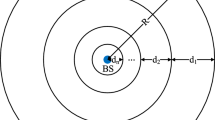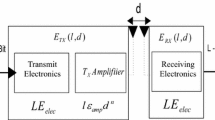Abstract
Wireless sensor networks can be used to monitor the interested region by multi-hop communication. Since sensor nodes are equipped with energy-limited batteries, energy conservation in such networks is of paramount importance in order to prolong the network lifetime. In this paper, considering the constrained radio range of node, we propose an energy efficient clustering division scheme from the viewpoint of energy consumption. The difference between our scheme and previous schemes is that ours is a non-uniform clustering hierarchy. With the algorithm that is proposed by this paper, we can divide the cluster into multiple non-uniform concentric rings and obtain the optimal thickness of each ring. Motivated by the derived results, every sensor node can adjust its radio range for transmission. Our extensive simulation results indicate that the proposed non-uniform clustering division scheme outperforms the conventional uniform clustering division schemes in terms of energy consumption and lifetime. The future research that should be explored is also discussed finally.
Similar content being viewed by others
References
Akyildiz I.F., Su W., Sankarasubramaniam Y., Cayirci E. (2002). Wireless sensor networks: A survey. Computer Networks 38(4):393–422
Deborah, E., Ramesh, G., Heidemann, J., & Kumar, S. (1999). Next century challenges: Scalable coordination in sensor networks. Proc. 5th ACM Ann. Int’l Conf. Mobile Computing and Networking (MOBICOM), (pp. 263–270).
Heinzelman, W., Chandrakasan, A., & Balakrishnan, H. (2000). Energy-efficient routing protocols for wireless microsensor networks. Proc. 33rd Hawaiian Int’l Conf. System Sciences (HICSS), (pp. 3005–3014).
Lindsey S., Raghavendra C., Sivalingam K.M. (2002). Data gathering algorithms in sensor networks using energy metrics. IEEE Transactions on Parallel and Distributed Systems 13(9):924–935
Yanagihara K., Taketsugu J., Fukui K., Fukunaga S., Hara S., Kitayama K. (2007). EACLE: Energy-aware clustering scheme with transmission power control for sensor networks. Wireless Personal Communications 40(3):401–415
Bandyopadhyay S., Coyle E.J. (2004). Minimizing communication costs in hierarchically-clustered networks of wireless sensors. Computer Networks 44(1):1–16
Jin, Y., Wang, L., Kim, Y., & Yang, X. Z. (2006). EEMC: An energy efficient multi-tier clustering algorithm for large-scale wireless sensor networks. Proc. 2nd IEEE Int’l Conf. Wireless Communications, Networking and Mobile Computing (WICOM).
Ye, W., Heidenmann, J., & Estrin, D. (2002). An energy-efficient MAC protocol for wireless sensor networks. Proc. 21st IEEE Int’l Conf. Computer and Communications (INFOCOM), (pp. 1567–1576).
Gao Q., Blow K.J., Holding D.J., Marshall I.W., Peng X.H. (2006). Radio range adjustment for energy efficient wireless sensor networks. Ad Hoc Networks 4(1):75–82
Wang, X., Xing, G., Zhang, Y., Lu, C., Pless, R., & Gill, C. (2003). Integrated coverage and connectivity configuration in wireless sensor networks. Proc. 1st ACM Conf. on Embedded Networked Sensor Systems (SENSYS), (pp. 28–39).
Jin, Y., Wang, L., Yang, X. Z., & Wen, D. X. (2007, in press). Analysis of coverage problem under border effects in wireless sensor networks. High Technology Letters, 13(4).
Pan J., Cai L., Hou Y., Shi Y., Shen X. (2005). Optimal base-station locations in two-tiered wireless sensor networks. IEEE Transactions on Mobile Computing 4(5):458–473
Mhatre V., Rosenberg C., Kofman D., Mazumdar R., Shroff N. (2005). A minimum cost heterogeneous Sensor network with a lifetime constraint. IEEE Transactions on Mobile Computing 4(1): 4–15
Kerschner R. (1939). The number of circles covering a set. American Journal of Mathematics 61(3):665–671
Mhatre V., Rosenberg C. (2004). Design guidelines for wireless sensor networks: Communication, clustering and aggregation. Ad Hoc Networks 2(1):45–63
Author information
Authors and Affiliations
Corresponding author
Rights and permissions
About this article
Cite this article
Jin, Y., Wang, L., Kim, Y. et al. Energy Efficient Non-uniform Clustering Division Scheme in Wireless Sensor Networks. Wireless Pers Commun 45, 31–43 (2008). https://doi.org/10.1007/s11277-007-9370-4
Received:
Accepted:
Published:
Issue Date:
DOI: https://doi.org/10.1007/s11277-007-9370-4




